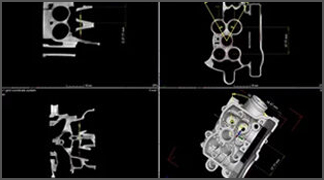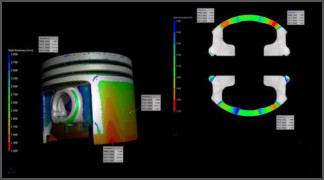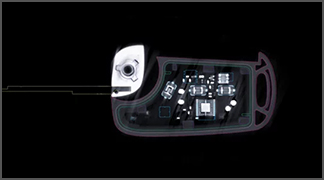CT Scanning - Services by Industry
We help companies from a wide
variety of industries internally inspect
their parts & assemblies with our
CT scanning inspection services.
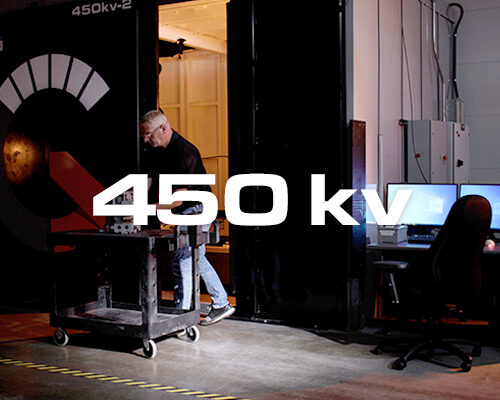
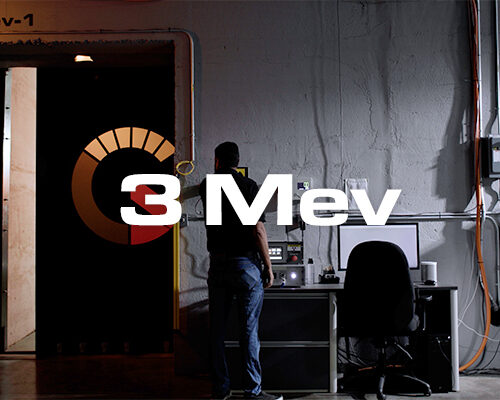
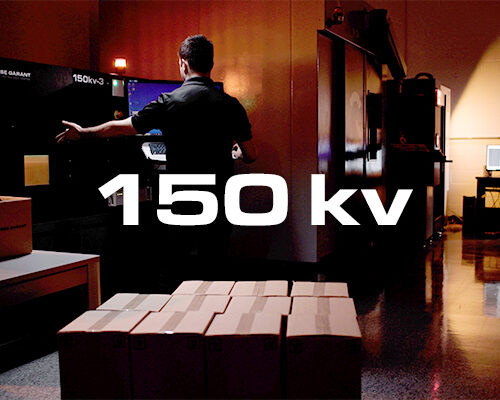
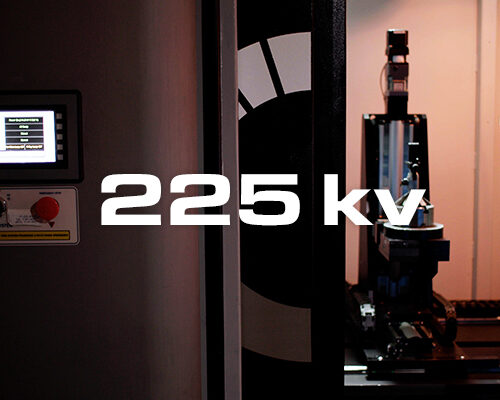
Supported Industries
You have reached our knowledge page on
CT scanning by Industry.
( CLICK TABS EXPAND )
AEROSPACE
For the aerospace and space industries, there are 4 primary areas that have had a large amount of success when adopting CT Scanning. These areas include:
Risk Reduction of Critical Parts & Assemblies
Safety during flight is very important and because of this must run components cannot fail. As opposed to performing a root cause failure investigation after a critical component failure, proactive inspection continues to be the aerospace method of choice. To reduce the risk of critical components failing CT scanning has proved beneficial in cases of separation, identifying cracks, pores, or this inconsistencies in wall thickness. Castings, sub assemblies, potted electronics, and 3D printed parts have been identified as a great fit for using computed tomography for proactive inspection. Also as computed tomography grows in adoption, some of these high value parts can even be 100% inspected with computed tomography for new products or for MRO instances when the risk factor needs to be reduced further before flight.
Reducing Costs
Typically traditional manufacturing and inspection techniques have proven to be highly effective in verifying production products. However, during the launch of new products (FAI – First Article Inspection) or annual qualifications of production runs (LAI – Last Article Inspection), AS9102 Form 3 measurement costs and time frames can really stack up. When utilizing CAT scan inspection, products can be quickly validated without destructive means to save on costly samples being manufactured and allowing additional downstream testing to be performed on the same component. Furthermore the utilization of surface profiles in the 3D realm allows for a detailed color map aligned by the customers preferred datum scheme for a visual insight paired with key dimensions being measured.
Impressing the OEM
There is no doubt that 2D X-Ray & 3D X-Ray inspection has been beneficial identifying internal failures and communicating them with the OEM or the supplier. As companies continue to adopt NDT (Non-Destructive Testing) digital imaging technologies, CT scanning inspection will ultimately become widely used in the aerospace industry in the coming years. Tier 1 manufacturers who begin to adopt the technology sooner will not only improve the overall quality of their product, but they will also be the first to align with emerging OEM and Prime Manufacturer CT inspection requirements and ultimately become the supplier of choice.
Benefiting from Service Labs
As the technology is rapidly being adopted and standards are evolving all the time, utilizing an aerospace CT certified service lab ensures proper compliance to the latest standards. This ensures the project is completed according to a verifiable process and the experienced lab can not only complete the results but communicate the results. As computed tomography data is complex, large in file size, and new for some people; effective communication is key to ensure all parties are properly informed of the results for effective decisions to be made.
ARCHAEOLOGY
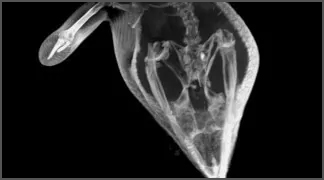
For the archaeology and paleontology industry, there are 3 primary areas that have had a large amount of success when adopting CT Scanning. These areas include:
Gaining Insight into the Sample
X-Ray and CT scanning technology has yielded valuable insight for research in archaeology and paleontology by obtaining detailed images of internal features that were once inaccessible. Fossils can be virtually sliced in 3D with CT Scanning providing critical data of features like bone distribution and verifying skeletal, dental structures, and other anatomical features. Actual/nominal comparisons are also available with computed tomography. For example, surface data from one specimen can be superimposed upon another to identify subtle differences in morphology which can be measured with a high dimensional accuracy. The versatility of CT inspection lends itself to a wide range of artifacts and other inorganic samples as the samples become smaller and Micro-CT scanning allows for improved scan resolution and insight. CT can even virtually remove surrounding material like soil or gypsum from buried archaeological artifacts like coins, fossils, and ancient remains.
Data Archiving
CT scanning is a useful Non-Destructive Testing (NDT) technique for conservation and natural history, providing high resolution imaging of a wide range of materials, from metals and ceramics to glass and organic material. For example, these advanced imaging technologies can aid in the data acquisition of museum artifacts through reverse engineering, obtaining the internal surface data to 3D print detailed replicas. In this way, museums can showcase replicas of fragile or unique artifacts and improve interactivity within their exhibitions. As CT scan data is digital it allows for perseveration of the original sample, data archiving for long term storage purposes, and data sharing for allowing multiple people to interact an unlimited number of times with the scan data.
Benefiting from Service Labs
As the technology is rapidly being adopted and evolving all of the time, utilizing a qualified service lab ensures proper controls during the outsourcing process. This ensures the parts are handled properly, the project is completed according to a verifiable process, data is properly stored, and the experienced lab can not only complete the results but communicate the results. As computed tomography data is complex, large in file size, and new for some people; effective communication is key to ensure all parties are properly informed of the results for effective decisions to be made.
AUTOMOTIVE
For the automotive industry, there are 4 primary areas that have had a large amount of success when adopting CT Scanning. These areas include:
Failure Investigation
For the automotive industry in North America, failure investigation using CT scanning has been the primary need for accessing the technology. When a failure is identified, usually the customer is experiencing pressure by their customer to quickly identify the root cause of the failure in additional to mitigating the financial impact the failure could cause. As a non-contact nondestructive testing (NDT) method, X-Ray and CT scanning can identify internal failures without destroying the part and preserving its original condition during the forensic investigation. With CAT scan technology, failing parts can be compared to known good parts or the 3D part data to further aid in the identification of a physical geometry defect that could be occurring. Instances that have proven highly beneficial for identifying failures for automotive parts are battery applications, potted electronics, movement of mechanical assemblies, fuel injectors, and casting applications.
Insight for Quality Control
During the launch of new products, sometimes the quality department requires another level of assurance to verify the component or the fit of internal features within an assembly. Computed tomography has proven to be highly beneficial in virtually sectioning through the product to ensure the part has been manufactured according to the design intent. This process can be applied not only after the manufacturing of the component but after performance testing. As cost savings and light weighting continue to evolve in the auto industry, insight into components becomes even more important. With the original component being unaltered, the same component can be inspected on one or multiple occasions which preserve the original product. Furthermore, the utilization of surface profiles in the 3D realm allows for a detailed color map aligned by the customers preferred datum scheme for a visual insight that can be paired with key dimensions being measured. For companies adhering to the VW specification developed for identifying voids of a specified size in critical stress areas, the computed tomography specification for 50096, 50097, P201, P202, and P203 requirements can be applied for compliance to the part print specification.
Impressing the OEM
There is no doubt that 2D X-Ray & 3D X-Ray inspection has been beneficial to identify internal failures and communicating them with the OEM or the supplier. As companies continue to adopt NDT (Non-Destructive Testing) digital imaging technologies, CT scanning inspection will ultimately become widely used in the automotive industry in the coming years for PPAP requirements and first article inspection (FAI). Tier 1 manufacturers who begin to adopt the technology sooner will not only improve the overall quality of their product, but they will also be the first to align with emerging OEM CT inspection requirements and ultimately become the supplier of choice.
Benefiting from Service Labs
As the technology is rapidly being adopted and standards are evolving all the time, utilizing a certified service lab ensures proper compliance to the latest standards. This ensures the project is inspected according to a verifiable process and the experienced lab can not only complete the results but communicate the results. As computed tomography data is complex, large in file size, and new for some people; effective communication is key to ensure all parties are properly informed of the results for effective decisions to be made.
CONSUMER PRODUCTS
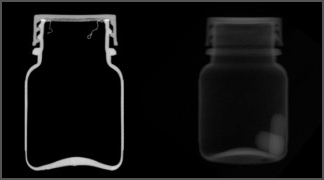
For the Consumer Products industry, there are 4 primary areas that have had a large amount of success when adopting CT Scanning. These areas include:
Qualifying New Products
Typically traditional manufacturing and inspection techniques have proven to be highly effective in verifying production products. However, when multi cavity tools for products and packaging applications require qualification the costs and time for validating measurements on multiple parts quickly adds up. CT Scanning not only has the ability to be a non-destructive testing (NDT) method to perform non-contact measurements of part features, but it can also provide a color-coded map identifying variations between cavities or variations to the nominal model. Furthermore, first article inspection (FAI) can be completed in regards to part print requirements allowing parts to be qualified in a free state environment where external forces are not being applied to the measured product.
Saving Material Costs
Depending on the production volumes, material consumption during production can quickly add up. When products are over-engineered or molded with too much material, creating a uniform wall thickness or reducing wall thickness in non-critical areas can save the manufacturer a significant amount of money on an annual basis. With CAT scan inspection wall thickness can be quickly validated as the technology is able to obtain internal and external part geometry in a single scan. Once 3D data is obtained, the computed tomography model can be analyzed against the specified material thickness and reported in a color map identifying variations in the wall thickness.
Failure Investigation
For the consumer parts industry, X-Ray and CT scanning failure investigation has proven beneficial for identifying the root cause of a potential failure. Identification of the failure not only allows companies to correct the error happening in production, but it also helps to identify a potential financial impact resulting from the failing products being used by consumers. When even further insight is required, Micro CT scanning with very high-resolution systems can identify slight changes in geometry which could stack up to result in the overall failure. Industrial CT Scanning can provide data for virtually all physical defect types external and internal to the product. These include porosities, voids, and cracks, assembly misalignments, inconsistent wall thickness, changes in material density, and variations from the nominal CAD model.
Benefiting from Service Labs
As the technology is rapidly being adopted and standards are evolving all the time, utilizing a certified service lab ensures proper compliance to the latest standards. This ensures the project is completed according to a verifiable process and the experienced lab can not only complete the results but communicate the results. As computed tomography data is complex, large in file size, and new for some people; effective communication is key to ensure all parties are properly informed of the results for effective decisions to be made.
DEFENSE & ARMS
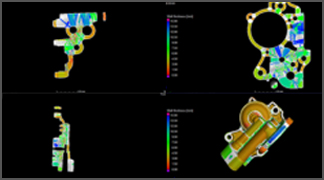
For the Defense industry, there are 3 primary areas that have had a large amount of success when adopting CT Scanning. These areas include:
Validation of Must Run Parts
Typically in defense applications, components cannot fail when in use. Parts and assemblies that fail to function properly could compromise the loss of data, critical time, or the lives of the soldiers who protect us. CT scanning can provide another level of reassurance on top of proven manufacturing techniques to further reduce the risk of a compromised product escape. Visualizing the internal cross-sectional slices of a CAT scanned part or identifying physical geometry variations has been proven to aid defense companies and their suppliers to ensure a quality product is being used. Going a step further first article inspection can also be completed in a free state environment and preserving the integrity of the original component to allow it to undergo further testing or be approved for use in a production environment. Depending on the overall cost or key function of the product, sometimes CT inspection of every sample can be cost justified in very specific scenarios. Over the years CT scanning has proved to be highly beneficial for validating castings, potted assemblies, complex assemblies, and additive manufactured components.
Failure Investigation
For the defense industry, X-Ray and CT scanning failure investigation has proven beneficial for identifying the root cause of a potential failure. Identification of the failure not only allows companies to correct the error happening in production, but it also helps to identify the root cause of the failure so the issue can be properly corrected. Industrial computed tomography can provide data for virtually all physical defect types external and internal to the product. These include porosities, voids, and cracks, assembly misalignments, inconsistent wall thickness, and physically separating defects in electronics. CAT scan technology can even be used to compare good parts or the 3D design data to the failing product to aid the customer in identification of a physical geometry defect that could be occurring. For very high value parts CT scanning in the right application can screen and reintroduce some of these costly products back into the supply chain by passing or failing the product based upon the defect in question.
Benefiting from Service Labs
As the technology is rapidly being adopted and standards are evolving all the time, utilizing a certified defense approved CT service lab ensures proper compliance to the latest standards and requirements. This ensures the project is completed according to a verifiable process and the experienced lab can not only complete the results but communicate the results. As computed tomography data is complex, large in file size, and new for some people; effective communication is key to ensure all parties are properly informed of the results for effective decisions to be made.
ENERGY & ELECTRICITY
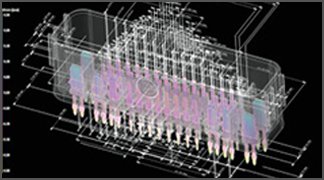
For the Energy & Electricity industry, there are 3 primary areas that have had a large amount of success when adopting CT Scanning. These areas include:
Validation of Must Run Parts
Typically in energy applications, components cannot fail when in use for nuclear, power generation, and power transfer applications. Parts and assemblies that fail to function properly could compromise the loss of power resulting downtime, labor being incurred, and the application not being completed. CT scanning can provide another level of reassurance on top of proven manufacturing techniques to further reduce the risk of a compromised product escape. Visualizing the internal cross-sectional slices of a CAT scanned part or identifying physical geometry variations has been proven to aid companies and their suppliers to ensure a quality product is being used. Depending on the overall cost or key function of the product, sometimes CT inspection of every sample can be cost justified in very specific scenarios. Some of these instances for high voltage applications include inspection of ceramic insulators and epoxy insulating materials. For nuclear applications CT inspection of pipes, additive / 3d printed products, high performance batteries, seals, embedded circuits, and assemblies have been key in validating the installed product to reduce costly downtime that is not scheduled.
Failure Investigation
X-Ray and CT scanning for failure investigation has proven beneficial for identifying the root cause of a potential failure. Identification of the failure not only allows companies to correct the error in new products, but it also helps to identify the root cause of the failure so the issue can be properly corrected. Industrial computed tomography can provide non-destructive testing (NDT) data for virtually all physical defect types external and internal to the product. These include porosities, voids, and cracks, assembly misalignments, potting fill issues, inconsistent wall thickness, and physical defects that have occurred in electronics. CAT scan technology can even be used to compare good parts or the 3D design data to the failing product to aid the customer in identification of a physical geometry defect that could be occurring. For very high value parts CT scanning in the right application can screen and reintroduce some of these costly products back into the supply chain by passing or failing the product based upon the defect in question.
Benefiting from Service Labs
As the technology is rapidly being adopted and standards are evolving all the time, utilizing a certified service lab ensures proper compliance to the latest standards and requirements. This ensures the project is completed according to a verifiable process and the experienced lab can not only complete the results but communicate the results. As computed tomography data is complex, large in file size, and new for some people; effective communication is key to ensure all parties are properly informed of the results for effective decisions to be made.
ENGINEERED PRODUCTS
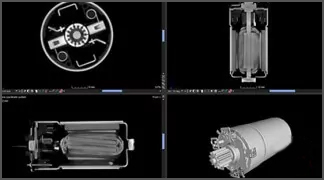
For mechanically engineered products, there are 3 primary areas that have had a large amount of success when adopting CT Scanning. These areas include:
Qualifying New Products
Typically traditional manufacturing and inspection techniques have proven to be highly effective in verifying manufactured products. When complex parts with internal features require qualification, the costs and time for validating measurements quickly adds up. CT Scanning not only has the ability to be a non-destructive testing (NDT) method to perform non-contact measurements of part features, but it can also provide a color-coded map identifying variations between products or variations to the nominal CAD model. In additional to a color map, for products that require first article inspection (FAI) completed to part print requirements, CT scanning in specific instances has proven highly beneficial to accomplish this in a free state environment without applying any unnecessary forces to the product being measured. Benefits have been seen for a variety of products including valves, connectors, fittings, castings, assemblies, sensors, welded components, brazed assemblies, additively manufactured components, piping applications, heat exchangers/radiators, and micro products.
Failure Investigation
For engineered parts & assemblies, X-Ray and CT scanning failure investigation has proven to be beneficial for identifying the root cause of a potential failure. Identification of the failure not only allows companies to correct the error happening, but it also helps to identify a potential financial impact resulting from the failing products being used by the end user. When even further insight is required on small samples or sections of samples, Micro CT scanning with very high-resolution systems can identify slight changes in geometry which could stack up to result in the overall failure. Industrial CT Scanning can provide data for virtually all physical defect types external and internal to the product. These include porosities, voids, and cracks, assembly misalignments, inconsistent wall thicknesses, changes in material density, and variations from the nominal CAD model.
Benefiting from Service Labs
As the technology is rapidly being adopted and standards are evolving all the time, utilizing a certified service lab ensures proper compliance to the latest standards. This ensures the project is completed according to a verifiable process and the experienced lab can not only complete the results but communicate the results. As computed tomography data is complex, large in file size, and new for some people; effective communication is key to ensure all parties are properly informed of the results for effective decisions to be made.
FORENSICS
For the forensics industry, there are 3 primary areas that have had a large amount of success when adopting CT Scanning. These areas include:
Failure Investigation
For the forensics investigation industry, internal failure investigation using CT scanning has been the primary benefit for accessing the technology. When a failure is identified, usually the customer is experiencing pressure by their customer to quickly identify the root cause of the failure in additional to mitigating the financial impact the failure could cause. As a non-contact nondestructive testing (NDT) method, X-Ray and CT scanning can identify internal failures without destroying the part and preserving its original condition during the forensic investigation. With CAT scan technology, failing parts can be compared to known good parts or the 3D design data to further aid in the identification of a physical geometry defect that could be occurring such as thin wall conditions or components being improperly manufactured.
Supporting Lawsuits
Forensics has the ability to play a pivotal role in legal matters or patent infringements as it can supply undisputable physical evidence. As the product in question is scanned in a free state environment with no external forces being applied, insight into the component with CT scanning allows internal part features to be viewed with detail all without disassembling the component. Providing the scan resolution is high enough, CT Scanning can identify and characterize virtually all types of external and internal physical defects including cracks, inclusions, porosities, inconsistent wall thicknesses, and other faulty features. For example, in highly visible legal cases CT scanning has been able to assess the fit and function of a seat belt, battery failure, or airbag components for confirming a failure for recalls and government penalties. CT also provides critical data for consumer products that have been damaged by fire due to electrical shorts or other defects. Furthermore, if two distinct parts require comparison, the technology has the ability to evaluate parts with respect to each other (Part to Part) or against a CAD model (Part to CAD). In this way, manufacturers receive critical insights on similarities and differences between authentic products and imitations or reproductions.
Benefiting from Service Labs
As the technology is rapidly being adopted and standards are evolving all the time, utilizing a certified service lab ensures proper compliance to the latest standards. This ensures the project is completed according to a verifiable process and the experienced lab can not only complete the results but communicate the results. As computed tomography data is complex, large in file size, and new for some people; effective communication is key to ensure all parties are properly informed of the results for effective decisions to be made.
GEOLOGY
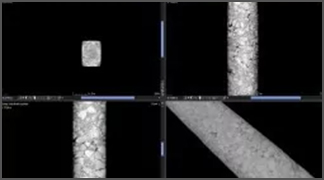
For the geology industry, there are 2 primary areas that have had a large amount of success when adopting CT Scanning. These areas include:
Internal Composition Structure
For the geology industry, the primary benefit for accessing the technology to preserve the condition of the original samples while gaining insight in regard to the internal composition. Industrial computed tomography is a useful tool for core sample testing of natural substances like sediments and rocks as well as manmade materials like ceramics, asphalt, concrete, and softer materials. Our industrial CT scanning services can identify the internal composition of core samples by material density and characterize internal features, cracks, and porosities without disturbing or altering samples. The technology can provide critical core sample data for a variety of applications including ore evaluations for mining and petroleum industries and inspecting soil samples for civil engineering purposes. Independent non-destructive testing (NDT) can yield valuable insight for material evaluation of a wide range of minerals including clays, refractory substances, metal ores, silicates, and mixed materials samples. CT technology offers advantages over conventional methods like optical inspection for dimensional and geometric analyses of cut gemstones like diamonds and sapphires. As an x-ray-based technology which utilizes changes in density, CT scanning can perform inspection and measurement of clear or reflective materials as it does not require the use of touch probes or exterior forces to perform the inspection.
Benefiting from Service Labs
As the technology is rapidly being adopted and standards are evolving all the time, utilizing a certified service lab ensures proper compliance to the latest standards. This ensures the project is completed according to a verifiable process and the experienced lab can not only complete the results but communicate the results. As computed tomography data is complex, large in file size, and new for some people; effective communication is key to ensure all parties are properly informed of the results for effective decisions to be made.
MEDICAL
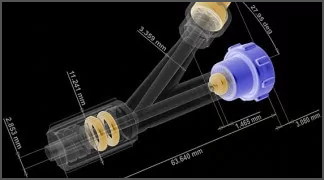
For the Medical Device industry, there are 4 primary areas that have had a large amount of success when adopting CT Scanning. These areas include:
Qualifying New Products
Typically traditional manufacturing and inspection techniques have proven to be highly effective in verifying production products. However, when multi cavity tools require qualification the costs and time for validating measurements on multiple parts quickly adds up. CT Scanning not only has the ability to be a non-destructive testing (NDT) method to perform non-contact measurements of part features, but it can also provide a color coded map identifying variations between cavities or variations to the nominal model. During the launch of new products (FAI – First Article Inspection) or annual qualifications of production runs (LAI – Last Article Inspection), measurement costs and time frames can really stack up. When utilizing CAT scan inspection, products can be quickly validated without destructive means to save on costly samples being manufactured and allow for additional downstream testing to be performed on the same component. Furthermore, the utilization of surface profiles in the 3D realm allows for a detailed color map aligned by the customers preferred datum scheme to be completed and paired with key dimensional measurements. Medical devices of a wide variety of materials and sizes have benefited from the use of CT scanning such as 3D printed parts, cobalt alloy orthopedics, prosthetics, plastic parts, dental braces, implantable devices, gel caps, and intricate multi-material assemblies made from ceramic, glass, plastic, titanium, and other performance materials.
Failure Investigation
X-Ray and CT scanning in a failure investigation has proven beneficial for identifying the root cause of a potential medical device failure. Identification of the failure not only allows companies to correct the error happening in production, but it also helps to identify a potential financial impact resulting from the failing products being used by hospitals or consumers. When even further insight is required, Micro CT scanning with very high-resolution systems can identify slight changes in geometry which could stack up to result in a overall failure. Industrial CT Scanning can provide data for virtually all physical defect types external and internal to the product. These include porosities, voids, and cracks, assembly misalignments, inconsistent wall thickness, variations in material density, and variations from the nominal CAD model.
Supporting Lawsuits
CT scanning has been a pivotal role in legal matters or patent infringements as it can supply undisputable physical evidence. As the product in question is able to be scanned in a free state environment with no external forces being applied, insight into the component with CT scanning allows internal part features to be viewed in great detail without disassembling the component. Providing the scan resolution is high enough, CT Scanning can identify and characterize virtually all types of external and internal physical defects, including cracks, inclusions, porosities, inconsistent wall thicknesses, and other faulty features. For example, CT can assess the fit and function of a surgical device and implantable devices during a failure or recall investigation. CT also provides critical data for medical devices that have stopped working due to electrical shorts or other mechanical defects. Furthermore, if two distinct parts require comparison, the technology has the ability to evaluate parts with respect to each other (Part to Part) or to a CAD model (Part to CAD). In this way, manufacturers can receive critical insights on similarities and differences between authentic products and imitations / reproductions.
Benefiting from Service Labs
As the technology is rapidly being adopted and standards are evolving all the time, utilizing a certified service lab ensures proper compliance to the latest standards. This ensures the project is completed according to a verifiable process and the experienced lab can not only complete the results but communicate the results. As computed tomography data is complex, large in file size, and new for some people; effective communication is key to ensure all parties are properly informed of the results for effective decisions to be made.
